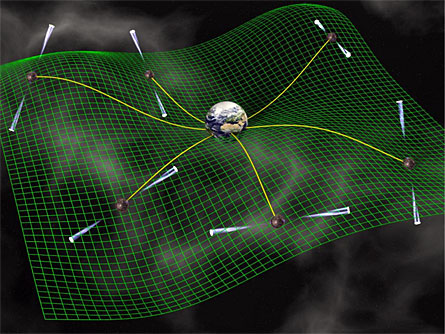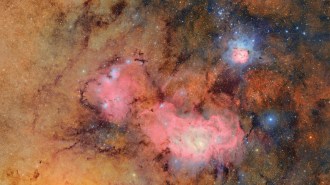DENVER — A bunch of dead stars could serve as ready-made recorders for gravitational waves — subtle ripples in spacetime that if discovered would be the crowning achievement of Einstein’s theory of general relativity, astronomers propose. Researchers have been spending billions of dollars to perfect sensitive, kilometer-long devices on the ground and launch even more sophisticated experiments in space to detect this cosmic symphony.

The new search technique would instead rely on radio waves generated like clockwork by millisecond pulsars — the collapsed remnants of massive stars that spin about once every one to 10 milliseconds. The speed at which these pulsars rotate enables researchers to measure the timing of the waves’ arrival at Earth with high accuracy.
Measuring arrival time is critical, says Frederick Jenet of the University of Texas at Brownsville and Texas Southmost College, who presented his team’s proposal on May 3 at the American Physical Society meeting. Colleague Andrea Lommen of Franklin & Marshall College in Lancaster, Pa., reported additional details on May 5.
A gravitational wave passing by the pulsar would warp spacetime, altering the arrival time of the radio waves at Earth ever so slightly. First the pulses would appear a little earlier, then a little later. The changes in arrival time would depend predictably on the phase and direction of propagation of the gravitational wave, as well as its distance from the pulsar, Jenet notes.
To detect a general background of gravitational waves, astronomers would need to monitor 20 millisecond pulsars for five to 10 years, with the arrival time of the radio waves determined to an accuracy of 100 nanoseconds, Jenet estimates. Recording gravitational waves from a pair of merging supermassive black holes would require five pulsars with radio wave arrival times known to an even higher accuracy, 10 nanoseconds, he adds.
“We currently have about 20 millisecond pulsars, but only five of these can be timed to the needed precision,” he notes. Astronomers need to find more millisecond pulsars in order to conduct the proposed search.
The pulsar technique, Jenet says, is best suited for recording long-period gravitational waves — those with a period of months to years — because those waves would induce the largest fluctuations in the arrival time of the radio waves. Intriguingly, long-period gravitational waves are preferentially generated by pairs of the most massive black holes — the giant beasts that lie at the center of galaxies.
The idea of using pulsars to search for gravitational waves dates back to the late 1970s, Jenet says, but only recently have dedicated searches begun worldwide. “Personally, the romantic notion of building a galactic-scale gravitational wave observatory using exotic stars as part of the instrument itself seems quite appealing,” he says.
Using pulsars to search for gravitational waves “is not a crazy idea but a well-established area of research,” says Tom Prince of Caltech. Both the increased sensitivity of radio telescopes and the discovery of additional millisecond pulsars have taken the idea from intriguing to practical.
Prince leads an effort to launch a gravitational wave detector called LISA into space sometime in the next decade. LISA uses a trio of spacecraft, each housing a freely floating test mass, to record the passage of a gravitational wave. LISA will detect high-frequency gravitational waves produced by stellar-size black holes and neutron stars, which the pulsar method can’t. But the pulsar method is available now, without the need for new telescopes, Jenet says.
Scientists are currently using several large-scale gravitational-wave detectors on Earth, including the twin LIGO detectors, one located near Livingston, La., and the other in Hanford, Wash.







